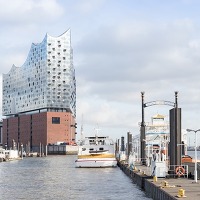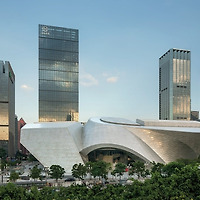
Li Ling Art City is a new city section entirely devoted to ceramic art. Not a regular city, this is a special one, where the relationship between architecture, urban space and the material made by the company and industrial tradition merge into one. This is why our project started from examining exactly which products and ceramic materials have been and are now made in this area to highlight their features, differences in color and workmanship.
We think that a city like this should give visitors the impression of being in a place like no other, not just in the midst of buildings, but in the midst of high quality industrial production. Ceramics are essentially vases, containers. The buildings themselves become containers. Between them, a relationship forms, so that ceramic pieces are like buildings that people move around. This means that the container - vase and container - city/building merge into one. We started from a detailed study of the juxtaposition and combination of these parts, seeking to envision a city section that could be flexible, with interchangeable parts, where the spaces could be an evocative sequence in which visitors are in the “between” space, having an experience of being in between the city space. This is a city with pedestrian streets where pedestrians can go in the spaces waiting to be discovered. Within these places, there are addition spaces focused on ceramic arts, intended to teach about how this great tradition of making and decorating ceramics works.

It is an urban whole with the trait of being a container and content at the same time. This is a major conceptual innovation within the contemporary discourse that constantly changes the relationship and dialogue between container and content. Some of the most beautiful contemporary museums have no relationship to the contents inside them. In contrast, we started from the idea of merging these two factors. Inside the building, it is a museum (as it holds objects to be exhibited). However, it is also a museum on the outside because the space generated between the volumes speaks eloquently of how we can experience, move through, touch and look at ceramic pieces.
By their nature, they are curved and sinuous, their shapes not completely regular like most buildings. This is why moving inside this city is first and foremost an experience. The hotel’s guests will have the experience of staying in a building that is simultaneously a large container. Spatially, it is an artistic installation. I think some of the installations by the Indian artist Anish Kapoor give an idea of the kind of space we can find here, which itself becomes a fantastical, imaginative place from its inception. This is why we expect there to be a large influx of visitors who want to see this city and discover what ceramic art and its universe means, from the smallest piece in the museum to the largest building.

The Ceramic Art City of Li Ling is not merely a part of a city or an industrial exhibition complex. As its name suggests, it is much more than this. It is a place and home of ceramic art, where industrial, cultural and production traditions merge with the expectations to see and learn of the visitors who are sure to be drawn to this city. When visitors come here, they shouldn’t find square buildings, rectangles, the usual pieces of a city seen in so many industrial places. Rather they should find a completely different, fantastical city of ceramic pieces, places where the building container and the ceramic contents merge and become one another. It should be a place where strolling around is fun, where there are no cars, only buildings designed like large vases, which visitors can walk into and visit, having the feeling of being inside a special world. This is what we think the new Art Center of Li Ling should be.
We think that this new city of ceramic art should be a fantastical, imaginative place, where we can walk in the “between” space, amidst the buildings. It should be a place where we can admire up close the largeness of the spaces, the curved dimensions of surfaces that are far from a traditional city, evoking a creative and imaginative world, like that of ceramics.
Text offer: Archea Associati

리링 세계도자예술도시
리링 세계도자예술도시(이하 예술도시)는 도예 예술을 위한 새로운 행정구역이다. 단순한 도시가 아니라 건축과 도시공간이 지역의 전통적인 산업과 기업이 관계를 이뤄 도시를 형성하고 있다. 어떠한 제품과 도자기를 사용하여 이곳을 형성하는지 파악하여 그것들의 특징과 차이점을 색깔과 기량의 차이로 강조하고자 하였다.
방문객들에게 예술도시에 대한 확실한 인상을 심어주고자 도시에서 건물과 건물 사이에 위치 하고 있는 것이 아니라, 하나의 커다란 공산품(도자기) 사이에 있다고 인식 하기를 원했다. 도자기는 본질적으로 용기로서 무언가를 담아내는 특징을 가지고 있고, 이러한 특징에서 영감을 받아 건물 자체가 용기로 인식 되고자 하였다. 도자기들 사이로 사람들이 돌아 다니는 것이 도자기들 간에 관계가 형성되면서 도자기들이 건물이 된다. 즉, 용기(도자기)와 용기(도시/건물)가 하나가 되는 것이다. 우리는 도시의 요소들이 병렬과 결합에 대한 자세한 연구를 시작하여 도시의 한 부분을 구상하고자 하였다. 떨어진 요소들이 서로 상호 소통 가능한 부분으로 방문객은 공간 ‘사이’에 있다는 것을 하나의 특별한 사건으로 경험하기를 원했다.

예술도시에서 보행로는 숨겨져 있는 것처럼 보인다. 이러한 방법을 통해 도예예술의 과정과 전통에 대한 설명하고자 하는 공간이 숨겨져 있다. 도시 전체가 그릇 형태를 취하면서 보행로 또한 포함되게 되는 것이다. 도시 전체는 그릇이라는 개념과 그릇이라는 형태가 지속적으로 대화함에 따라 그 관계가 변화하여 만들어내는 혁신적이고 현대적인 개념이다. 그동안 현대적이고 아름다운 박물관들은 그들이 담고 있는 전시품들과 건물 사이에 연관성을 이루지 못했다. 하지만 예술 도시는 이 두 가지 요소를 하나로 만들었다. 건물안은 전시실이 있는 박물관이지만, 건물의 외부도 박물관이 된다. 건물과 건물 사이 공간을 방문객들은 걸어 다니며 도자기를 보고 만지는 경험을 통해 또 하나의 전시실을 경험한다.
건물들은 일반적인 규칙적인 모양이 아니라, 구불구불하게 굴곡져 있다. 이에 내부의 동선은 이색적이고 특별한 경험이 된다. 호텔의 투숙객들은 건물 내부에 있는 것이 마치 거대한 그릇에 들어와 있는 느낌을 줄 것이다. 이러한 환상적이고 독창적인 도시의 아이디어는 인도의 예술가 Anish Kapoor의 설치 예술의 개념에서 비롯되고 있다. 이곳에 오는 많은 방문자들은 박물관의 작은 조각에서부터 커다란 건물을 통해서 도예와 그 분야가 무엇인지에 대해 발견할 수 있을것이다.

예술도시는 단순한 도시, 혹은 산업 박람회의 일부분이 아니다. 이름에서 알 수 있듯이, 그 이상의 의미를 가지고 있다. 이 곳은 산업, 문화, 생활의 관습을 이 도시를 통해 방문객들이 배울 수 있기를 기대 함께 기대하고 있다. 방문객들은 이 곳에서 산업화된 공간에서 흔히 볼 수 있는 사각형의 네모난 건물들은 발견 할 수 없을 것이다. 그들은 아름다운 도자기의 조각들과 공간들을 경험 할 것이다. 차는 존재 하지 않으며 용기 같은 건물들만 있어 단순히 걸어 다니는 것만으로도 즐거움이 되어 이색적인 공간에 대한 경험을 즐길 수 있을 것이다. 기존의 도시에서는 볼 수 없는 곡면과 공간의 크기에 압되고, 창의적이고 상상력을 불러일으키는 마치 도예와 같은 공간을 경험 할 수 있을 것이다.
글 제공: Archea Associati
Architect Archea Associati
Location Hunan, China
Use Museum, hotel
Area 210,000m2
Built area 69,000m2
Completion 2015
Design team Laura Andreini, Marco Casamonti, Silvia Fabi, Giovanni polazzi
Client Hunan liling multicolored underglaze city development co. ltd
Photographer Cristiano Bianchi, Pietro Savorelli, Nicola Saladino
해당 프로젝트는 건축문화 2월호(Vol. 429)에 게재 되었습니다.
The project was published in the February issue of the magazine (Vol. 429)
'Architecture Project > Cultural' 카테고리의 다른 글
| Elbphilharmonie Hamburg (0) | 2017.06.20 |
|---|---|
| Faena District (0) | 2017.06.20 |
| The Museum of Contemporary Art and Planning Exhibition (0) | 2017.06.20 |
| Akagane Museum (0) | 2017.06.20 |
| China Academy of Arts’ Folk Art Museum (0) | 2017.06.19 |
마실와이드 | 등록번호 : 서울, 아03630 | 등록일자 : 2015년 03월 11일 | 마실와이드 | 발행ㆍ편집인 : 김명규 | 청소년보호책임자 : 최지희 | 발행소 : 서울시 마포구 월드컵로8길 45-8 1층 | 발행일자 : 매일







